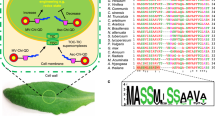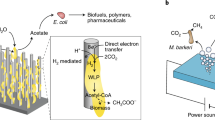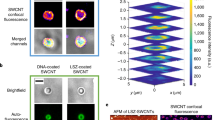Abstract
The interface between plant organelles and non-biological nanostructures has the potential to impart organelles with new and enhanced functions. Here, we show that single-walled carbon nanotubes (SWNTs) passively transport and irreversibly localize within the lipid envelope of extracted plant chloroplasts, promote over three times higher photosynthetic activity than that of controls, and enhance maximum electron transport rates. The SWNT–chloroplast assemblies also enable higher rates of leaf electron transport in vivo through a mechanism consistent with augmented photoabsorption. Concentrations of reactive oxygen species inside extracted chloroplasts are significantly suppressed by delivering poly(acrylic acid)–nanoceria or SWNT–nanoceria complexes. Moreover, we show that SWNTs enable near-infrared fluorescence monitoring of nitric oxide both ex vivo and in vivo, thus demonstrating that a plant can be augmented to function as a photonic chemical sensor. Nanobionics engineering of plant function may contribute to the development of biomimetic materials for light-harvesting and biochemical detection with regenerative properties and enhanced efficiency.
This is a preview of subscription content, access via your institution
Access options
Subscribe to this journal
Receive 12 print issues and online access
$259.00 per year
only $21.58 per issue
Buy this article
- Purchase on Springer Link
- Instant access to full article PDF
Prices may be subject to local taxes which are calculated during checkout




Similar content being viewed by others
Change history
21 March 2014
In the version of this Article originally published, in Fig. 4k, the scale bar should have been 16 μm, and in the sentence beginning “Leaves assembled with CoMoCAT…” the characteristic fluorescence peak for the (6,5) chirality should have read ‘(980–1,000 nm)’. These errors have now been corrected in the online versions of the Article.
References
Weise, S. E., Weber, A. P. M. & Sharkey, T. D. Maltose is the major form of carbon exported from the chloroplast at night. Planta 218, 474–482 (2004).
Boghossian, A. A. et al. Application of nanoparticle antioxidants to enable hyperstable chloroplasts for solar energy harvesting. Adv. Energy Mater. 3, 881–893 (2013).
Trench, R. K., Boyle, J. E. & Smith, D. C. The association between chloroplasts of Codium fragile and the mollusc Elysia viridis. I. characteristics of isolated Codium chloroplasts. Proc. R. Soc. B Biol. Sci. 184, 51–61 (1973).
Rumpho, M. E., Summer, E. J. & Manhart, J. R. Solar-powered sea slugs. Mollusc/algal chloroplast symbiosis. Plant Physiol. 123, 29–38 (2000).
Choe, H. & Thimann, K. The senescence of isolated chloroplasts. Planta 121, 201–203 (1974).
Green, B. J., Fox, T. C. & Rumpho, M. E. Stability of isolated algal chloroplasts that participate in a unique mollusc/kleptoplast association. Symbiosis 40, 31–40 (2005).
Neuhaus, H. E. & Schulte, N. Starch degradation in chloroplasts isolated from C3 or CAM (crassulacean acid metabolism)-induced Mesembryanthemum crystallinum L. Biochem. J. 318, 945–953 (1996).
Edelman, M. & Mattoo, A. K. D1-protein dynamics in photosystem II: The lingering enigma. Photosynth. Res. 98, 609–620 (2008).
Schmitz-Linneweber, C. et al. The plastid chromosome of spinach (Spinacia oleracea): complete nucleotide sequence and gene organization. Plant Mol. Biol. 45, 307–315 (2001).
Mar’in-Navarro, J., Manuell, A. L., Wu, J. P. & Mayfield, S. Chloroplast translation regulation. Photosynth. Res. 94, 359–374 (2007).
Bolton, J. R. & Hall, D. Photochemical conversion and storage of solar energy. Annu. Rev. Energy 4, 353–401 (1979).
Zhu, X.-G., Long, S. P. & Ort, D. R. Improving photosynthetic efficiency for greater yield. Annu. Rev. Plant Biol. 61, 235–261 (2010).
Blankenship, R. E. et al. Comparing photosynthetic and photovoltaic efficiencies and recognizing the potential for improvement. Science 332, 805–809 (2011).
Wilhelm, C. & Selmar, D. Energy dissipation is an essential mechanism to sustain the viability of plants: The physiological limits of improved photosynthesis. J. Plant Physiol. 168, 79–87 (2011).
Scholes, G. D., Fleming, G. R., Olaya-Castro, A. & van Grondelle, R. Lessons from nature about solar light harvesting. Nature Chem. 3, 763–774 (2011).
Han, J.-H. et al. Exciton antennas and concentrators from core–shell and corrugated carbon nanotube filaments of homogeneous composition. Nature Mater. 9, 833–839 (2010).
Zhang, J. et al. Single molecule detection of nitric oxide enabled by d(AT)(15) DNA adsorbed to near infrared fluorescent single-walled carbon nanotubes. J. Am. Chem. Soc. 20, 567–581 (2010).
Shi, X., von dem Bussche, A., Hurt, R. H., Kane, A. B. & Gao, H. Cell entry of one-dimensional nanomaterials occurs by tip recognition and rotation. Nature Nanotech. 6, 714–719 (2011).
Pogodin, S., Slater, N. K. H. & Baulin, V. a. Surface patterning of carbon nanotubes can enhance their penetration through a phospholipid bilayer. ACS Nano 5, 1141–1146 (2011).
Chen, J., Patil, S., Seal, S. & McGinnis, J. F. Rare earth nanoparticles prevent retinal degeneration induced by intracellular peroxides. Nature Nanotech. 1, 142–150 (2006).
Soll, J. & Schleiff, E. Protein import into chloroplasts. Nature Rev. Mol. Cell Biol. 5, 198–208 (2004).
Pogodin, S. & Baulin, V. a. Can a carbon nanotube pierce through a phospholipid bilayer?. ACS Nano 4, 5293–5300 (2010).
Leheny, E. A. & Theg, S. M. Apparent inhibition of chloroplast protein import by cold temperatures is due to energetic considerations not membrane fluidity. Plant Cell 6, 427–437 (1994).
Ma, X. et al. Single-walled carbon nanotubes alter cytochrome c electron transfer and modulate mitochondrial function. ACS Nano 6, 10486–10496 (2012).
Block, M. a, Douce, R., Joyard, J. & Rolland, N. Chloroplast envelope membranes: a dynamic interface between plastids and the cytosol. Photosynth. Res. 92, 225–244 (2007).
Liu, Q. L. et al. Carbon nanotubes as molecular transporters for walled plant cells. Nano Lett. 9, 1007–1010 (2009).
Lim, P. O., Kim, H. J. & Nam, H. G. Leaf senescence. Annu. Rev. Plant Biol. 58, 115–136 (2007).
Deshpande, S., Patil, S., Kuchibhatla, S. V. & Seal, S. Size dependency variation in lattice parameter and valency states in nanocrystalline cerium oxide. Appl. Phys. Lett. 87, 133113 (2005).
Sicard, C. et al. CeO2 nanoparticles for the protection of photosynthetic organisms immobilized in silica gels. Chem. Mater. 23, 1374–1378 (2011).
Asati, A., Santra, S., Kaittanis, C. & Perez, J. M. Surface-charge-dependent cell localization and cytotoxicity of cerium oxide nanoparticles. ACS Nano 4, 5321–5331 (2010).
Lonergan, T. A. & Sargent, M. L. Regulation of the photosynthesis rhythm in Euglena gracilis CS1-75. Plant Physiol. 64, 99–103 (1979).
Ham, M-H. et al. Photoelectrochemical complexes for solar energy conversion that chemically and autonomously regenerate. Nature Chem. 2, 929–936 (2010).
Boghossian, A. A., Ham, M.-H., Choi, J. H. & Strano, M. S. Biomimetic strategies for solar energy conversion: a technical perspective. Energy Environ. Sci. 4, 3834–3843 (2011).
Calkins, J. O., Umasankar, Y., O’Neill, H. & Ramasamy, R. P. High photo-electrochemical activity of thylakoid–carbon nanotube composites for photosynthetic energy conversion. Energy Environ. Sci. 6, 1891–1900 (2013).
Mubarakshina, M. M. et al. Production and diffusion of chloroplastic H2O2 and its implication to signalling. J. Exp. Bot. 61, 3577–3587 (2010).
Kim, J-H. et al. The rational design of nitric oxide selectivity in single-walled carbon nanotube near-infrared fluorescence sensors for biological detection. Nature Chem. 1, 473–481 (2009).
Wilson, I. D., Neill, S. J. & Hancock, J. T. Nitric oxide synthesis and signalling in plants. Plant. Cell Environ. 31, 622–631 (2008).
Tvrdy, K. et al. A kinetic model for the deterministic prediction of gel-based carbon nanotube separation. ACS Nano 7, 1779–1789 (2013).
Heller, D. A. et al. Multimodal optical sensing and analyte specificity using single-walled carbon nanotubes. Nature Nanotech. 4, 114–120 (2009).
Lilley, R. M., Fitzgerald, M. P., Rienits, K. G. & Walker, D. A. Criteria of intactness and the photosynthetic activity of spinach chloroplast preparations. New Phytol. 75, 1–10 (1975).
Arnon, D. Copper enzymes in isolated chloroplasts polyphenoloxidase in Beta vulgaris. Plant Physiol. 24, 1–16 (1949).
Huang, X. et al. Magnetic virus-like nanoparticles in N benthamiana plants: a new paradigm for environmental and agronomic biotechnological research. ACS Nano 5, 4037–4045 (2011).
Jiang, M. Water stress-induced abscisic acid accumulation triggers the increased generation of reactive oxygen species and up-regulates the activities of antioxidant enzymes in maize leaves. J. Exp. Bot. 53, 2401–2410 (2002).
Able, A., Guest, D. & Sutherland, M. Use of a new tetrazolium-based assay to study the production of superoxide radicals by tobacco cell cultures challenged with avirulent zoospores of Phytophthora parasitica var nicotianae. Plant Physiol. 117, 491–499 (1998).
Maxwell, K. & Johnson, G. N. Chlorophyll fluorescence—a practical guide. J. Exp. Bot. 51, 659–668 (2000).
Acknowledgements
We gratefully acknowledge support from the U.S. Department of Energy under grant number DE-FG02-08ER46488 (M.S.S., S.M.F., A.A.B., T.P.M., A.H.J.). This material is based on work supported by the National Science Foundation Postdoctoral Research Fellowship in Biology under Grant No. 1103600 (J.P.G.). The co-authors were also supported by the NSF PRFB Fellowship under Award No. 1306229 (M.P.L), NSF GRFP (N.F.R.), and DPU-ILTEM and TUBITAK (F.S). We also thank S. Blake, J. Zhang and Darmouth Senior B. Gibbons for assistance. W. Salmon and N. Watson (Whitehead M. Keck Microscopy facility) helped with training and technical advice on confocal and TEM microscopy.
Author information
Authors and Affiliations
Contributions
J.P.G. and M.S.S. conceived experiments and wrote the paper. J.P.G., M.P.L., S.M.F., T.P.M. and N.M.I. performed experiments and data analysis. A.A.B., F.S., A.J.H., N.F.R. and J.A.B. assisted in experiments and analysis.
Corresponding author
Ethics declarations
Competing interests
The authors declare no competing financial interests.
Supplementary information
Supplementary Information
Supplementary Information (PDF 2778 kb)
Supplementary Information
Supplementary Movie 1 (MOV 1693 kb)
Supplementary Information
Supplementary Movie 2 (MOV 2824 kb)
Rights and permissions
About this article
Cite this article
Giraldo, J., Landry, M., Faltermeier, S. et al. Plant nanobionics approach to augment photosynthesis and biochemical sensing. Nature Mater 13, 400–408 (2014). https://doi.org/10.1038/nmat3890
Received:
Accepted:
Published:
Issue Date:
DOI: https://doi.org/10.1038/nmat3890
This article is cited by
-
Proteomic insights to decipher nanoparticle uptake, translocation, and intercellular mechanisms in plants
Environmental Science and Pollution Research (2024)
-
Phytogenic nanoparticles: synthesis, characterization, and their roles in physiology and biochemistry of plants
BioMetals (2024)
-
Nanobiotechnology in crop stress management: an overview of novel applications
Discover Nano (2023)
-
Effect of nano-calcium carbonate on morphology, antioxidant enzyme activity and photosynthetic parameters of wheat (Triticum aestivum L.) seedlings
Chemical and Biological Technologies in Agriculture (2023)
-
Material-engineered bioartificial microorganisms enabling efficient scavenging of waterborne viruses
Nature Communications (2023)



